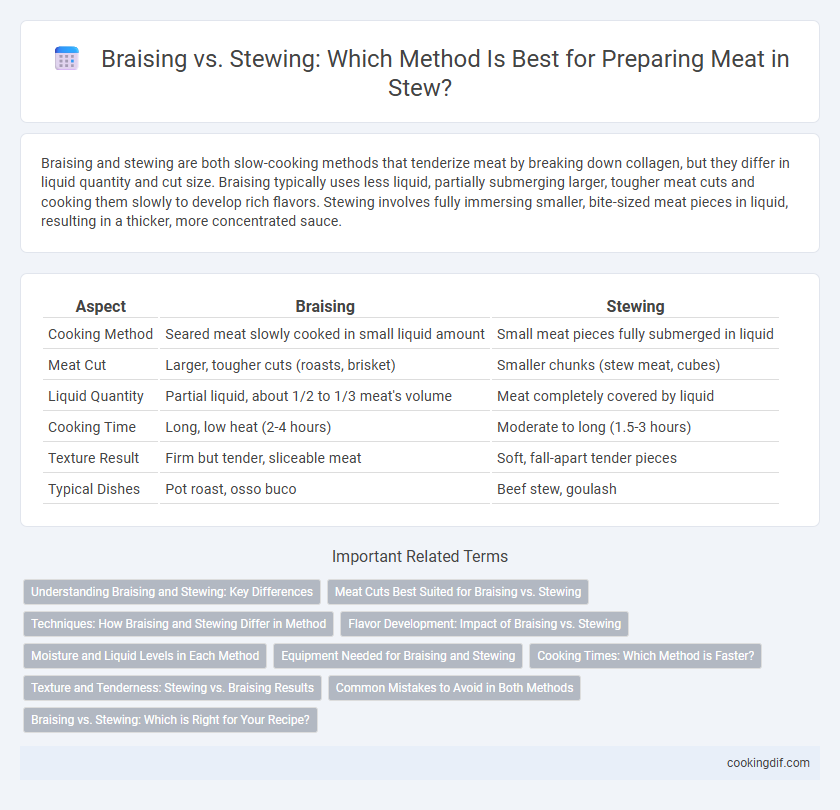Braising and stewing are both slow-cooking methods that tenderize meat by breaking down collagen, but they differ in liquid quantity and cut size. Braising typically uses less liquid, partially submerging larger, tougher meat cuts and cooking them slowly to develop rich flavors. Stewing involves fully immersing smaller, bite-sized meat pieces in liquid, resulting in a thicker, more concentrated sauce.
Table of Comparison
| Aspect | Braising | Stewing |
|---|---|---|
| Cooking Method | Seared meat slowly cooked in small liquid amount | Small meat pieces fully submerged in liquid |
| Meat Cut | Larger, tougher cuts (roasts, brisket) | Smaller chunks (stew meat, cubes) |
| Liquid Quantity | Partial liquid, about 1/2 to 1/3 meat's volume | Meat completely covered by liquid |
| Cooking Time | Long, low heat (2-4 hours) | Moderate to long (1.5-3 hours) |
| Texture Result | Firm but tender, sliceable meat | Soft, fall-apart tender pieces |
| Typical Dishes | Pot roast, osso buco | Beef stew, goulash |
Understanding Braising and Stewing: Key Differences
Braising involves cooking larger cuts of meat partially submerged in liquid at low temperatures for extended periods, resulting in tender, flavorful dishes with a caramelized exterior. Stewing uses smaller, uniform meat pieces fully submerged in liquid, allowing even cooking and a rich, thickened sauce as the collagen breaks down. Both methods optimize tenderness and flavor but differ in cooking vessel, liquid volume, and meat cut size, making them suited to distinct culinary applications.
Meat Cuts Best Suited for Braising vs. Stewing
Tough, larger cuts like chuck roast, brisket, and short ribs are best suited for braising due to their higher collagen content, which breaks down into tender, flavorful meat during slow, moist heat cooking. Stewing requires smaller, uniformly cut pieces from similar tough cuts such as stew beef or lamb shoulder, allowing even cooking and enhanced tenderness in the liquid-based method. Both techniques maximize flavor in economical cuts but differ in cut size and cooking vessel.
Techniques: How Braising and Stewing Differ in Method
Braising involves cooking larger cuts of meat partially submerged in a small amount of liquid at low heat, allowing the meat to become tender while preserving texture. Stewing requires cutting meat into smaller pieces fully submerged in liquid, which simmers slowly to break down connective tissues evenly. The primary difference lies in liquid volume and meat size, with braising using less liquid and larger cuts, while stewing uses more liquid and smaller pieces for consistent flavor absorption.
Flavor Development: Impact of Braising vs. Stewing
Braising typically uses larger meat cuts cooked slowly in a small amount of liquid, enhancing deep, caramelized flavors through Maillard reactions and concentrated juices. Stewing involves smaller, uniform pieces submerged in liquid, promoting uniform flavor absorption and tenderization but with a milder, more consistent taste profile. The choice between braising and stewing significantly impacts the intensity and complexity of flavor development in slow-cooked meat dishes.
Moisture and Liquid Levels in Each Method
Braising uses a small amount of liquid, partially submerging the meat to create a moist cooking environment, while stewing fully immerses the meat in liquid, promoting even heat distribution. The limited liquid in braising helps develop a rich, concentrated sauce as it simmers slowly with the meat. Stewing's higher liquid level tenderizes tougher cuts by breaking down connective tissues thoroughly throughout the cooking process.
Equipment Needed for Braising and Stewing
Braising requires a heavy, oven-safe pot such as a Dutch oven or a deep skillet with a tight-fitting lid to maintain moisture and heat evenly during slow cooking. Stewing typically uses a large, deep pot like a stockpot or a slow cooker that allows for fully submerging smaller meat pieces in liquid for uniform tenderness. Both methods benefit from heavy-bottomed cookware to prevent scorching and ensure consistent temperature control throughout the cooking process.
Cooking Times: Which Method is Faster?
Braising typically requires cooking meat at a lower temperature for a longer period, often 2 to 3 hours, to achieve tenderness and flavor development. Stewing involves smaller meat pieces cooked submerged in liquid, usually simmered for 1 to 2 hours, making it generally faster than braising. The choice between braising and stewing depends on desired texture and cooking time, with stewing offering a quicker method for tender meat.
Texture and Tenderness: Stewing vs. Braising Results
Braising involves cooking larger cuts of meat slowly in a small amount of liquid, resulting in a tender texture with a slightly firmer exterior compared to stewing. Stewing cuts meat into smaller pieces, fully submerging them in liquid, which breaks down collagen more thoroughly, producing a uniformly tender and soft texture. The difference in cooking methods directly affects meat tenderness, with stewing providing more consistent softness due to complete immersion and longer exposure to cooking liquid.
Common Mistakes to Avoid in Both Methods
Overcooking meat is a common mistake that results in dry, tough texture in both braising and stewing. Using too little liquid prevents proper heat distribution and can cause uneven cooking, compromising tenderness. Failing to brown meat before cooking reduces flavor development and depth in finished dishes.
Braising vs. Stewing: Which is Right for Your Recipe?
Braising involves cooking larger cuts of meat partially submerged in liquid at low heat, resulting in tender, flavorful dishes perfect for roasts or tougher cuts like brisket. Stewing uses smaller, uniformly cut pieces fully submerged in liquid, creating a thicker sauce and evenly cooked meat ideal for hearty meals such as beef stew or chicken stew. Choosing between braising and stewing depends on the cut size and desired texture, with braising highlighting individual pieces and stewing offering a cohesive, rich consistency.
Braising vs stewing for meat preparation Infographic

 cookingdif.com
cookingdif.com